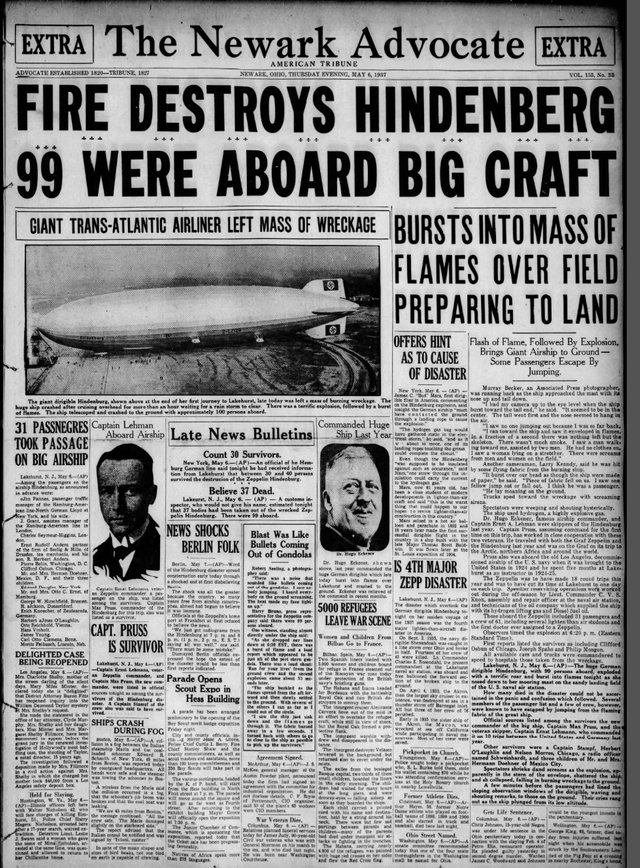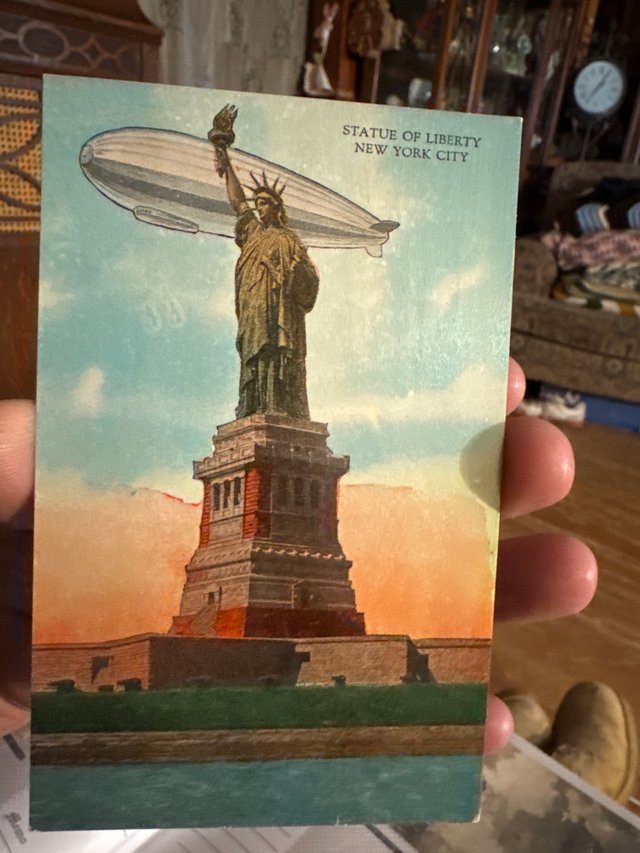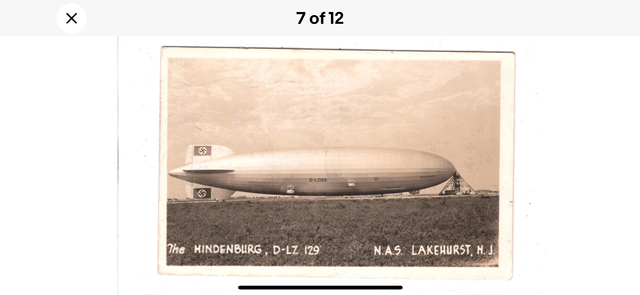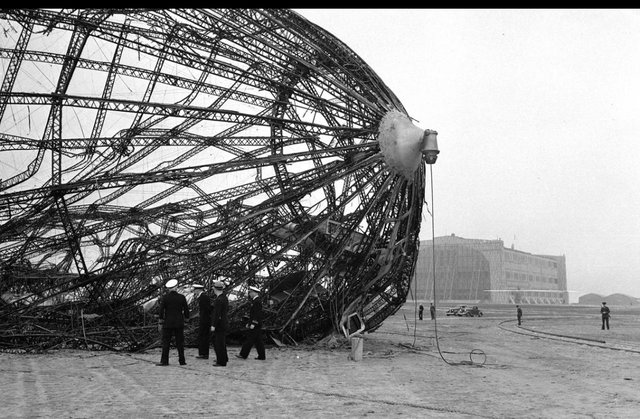This day in History May 6 1937 The Mighty Hindenburg, and my Family. Oh the Humanity!
This Day in History – May 6, 1937
“Oh, the Humanity”: The Day My Family Watched the Sky Fall in Fire
When modern pride met its match in a spark of static and a gust of wind
On a spring evening in 1937, the pride of Nazi Germany’s air fleet—the LZ 129 Hindenburg—exploded in a ball of fire over Lakehurst, New Jersey. But to me, it’s more than a chapter in a history book. My grandfather’s brother George Johnson was there, a lineman on the ground helping to guide the great floating zeppelin into place. It was not his first time, and he was a civilian. But on that day, while fighting the wind and the hydrogen, he saw This 803 foot 7 million cubic foot hydrogen filled symbol of aeronautic genius Explode, he felt the fire, he saw with his own eyes the chaos, and as men and woman fell from the burning wreak and ran from the caged flame he heard the screams.
He was there when the sky cracked open and rained flame.
It was supposed to be the future—graceful, efficient, awe-inspiring. The LZ 129 Hindenburg, pride of Nazi Germany’s air fleet, floated like a silver cathedral across the Atlantic, carrying passengers in opulence and speed. But on the evening of May 6, 1937, as it hovered above the airfield in Lakehurst, New Jersey, something went terribly wrong.
At 7:25 PM, with the ground crew grasping the mooring lines, the great airship burst into flames. Within seconds, it was engulfed. Thirty-six lives were lost. The world was stunned. And the voice of radio announcer Herbert Morrison echoed across the decades: “Oh, the humanity!”
But for my family, this was more than a broadcast. It was a memory. A grief. A moment passed down in stories and shadows for generations..
Family in the Fire
My grandfather’s brother, George Johnson, was there that day—part of the line crew assigned to guide the Hindenburg to the mooring tower. A WWI private turned airship handler,I was told that it took over 200 men to guide those great Airships in and the me. Would line up for the 1$ a day they could make if they were chosen.My grand uncle George stood among the men holding the ropes that day with a dollar in his pocket when the sky cracked open and flame consumed the giant. He saw it with his own eyes.
My grandfather told me about that day. How horrible it was. How George carried the weight of what he saw for the rest of his life. He later suffered from Parkinson’s and grew feeble, but never unkind. He kept horses near the barn, and I have a photo of him there, giving rides to nieces in a carriage when he still could.
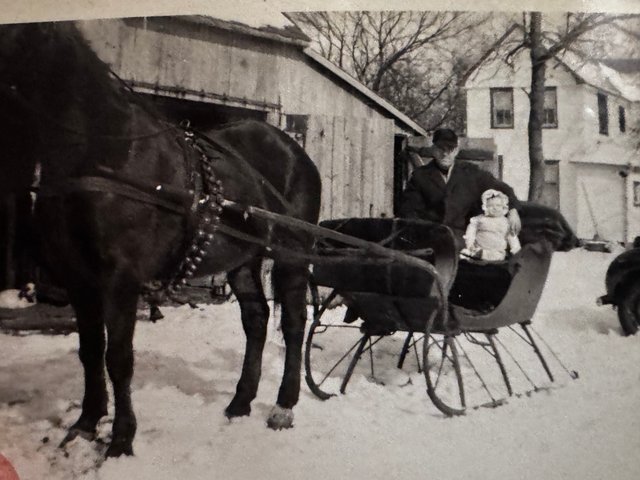
(This is George’s Brother, but this is the sleigh they used in the winter and the barn in the background)
Preston Brower, married to my grandfather’s sister Dot, was a fireman in Lakehurst at the time. He was there too—rushing into the blaze to rescue, to respond, to fight the inferno. Another relative, a fireman and grandson of my great-great-uncle Abe Johnson (himself gassed at Lorraine in WWI), joined the fight that day.
And then there was Aunt Emma. At the time of the Hindenburg disaster, she knew none of our family. Years later, her sister Helen would marry Ben—my Uncle George’s youngest brother—but in 1937, Emma was just 17. A young secretary, she rode her bicycle each day along the dusty roads of Route 571, from Pleasant Plains (now part of Toms River) to the Lakehurst Naval Air Station—about seven miles each way.
That day, as she pedaled toward work, she may have felt the ground tremble. She saw the sky ignite above the trees. The Hindenburg exploded—and everything changed. She stood at the roadside, witnessing one of the greatest disasters of the modern age unfold in fire and smoke.

Decades later, my mother—George’s niece—became a nurse at Paul Kimball Hospital in Lakewood, NJ, the very hospital where the wounded and dying were taken after the crash. She started there in 1962. I was born there in 1964. Even as a boy, when we drove past the Lakehurst hangar, the stories came back: the shadow of the zeppelin, the horror of that day, and again—“Oh, the humanity!”
My cousin told me of other relatives along the Jersey Shore who recalled seeing the Hindenburg in the sky earlier that day—huge, majestic, fateful.
Funny how folks are all kind of tied together like that sometimes. Not consciously or even noticeably at least not right away. And how a common thread weaves in the collected memory and emotions even after 88 years. Somethings just live in infamy and some in history but to me they live in my memory even though I was born almost 3 decades after the fact. And as I hear my grandparents in my mind it make me tear up as though I were there.
And I remember, as a child of five, seeing the later military blimps patrol the coast—smaller than the mighty Shenandoah or Akron or the doomed Hindenburg, but still casting great shadows. We'd look up and remember. And the stories would begin again.
The Broadcast Heard in Eden
As a historian and believer, I cannot help but hear another voice behind Morrison’s haunting cry. For if ever there was a disaster greater than the Hindenburg—more devastating, more lasting—it was the Fall of Man. And if heaven had had a radio broadcast that day in Eden, perhaps it would’ve sounded like this:
Broadcast from Eden – “Oh, the Humanity!”
Good evening, host of Heaven… I bring you now to the Garden of Eden. Behold the great and wonderful work of God: man—Adam and Eve—created in the very image and likeness of the Almighty. Amazing, aren’t they?
But—what is this I see? Oh my—
“It’s Adam, and he is crashing! He’s taken of the tree of the knowledge of good and evil—he’s biting into the fruit! Oh, the humanity! This is the worst catastrophe in the history of creation! Oh—he is crashing… Eve had reached into the Tree toward the sky, and she has given to Adam… It’s a terrific fall.
Angels and Archangels… Cherubim and Seraphim—what can I say? There’s sin, and there are flames. Hell is enlarging now, and the gates are open. Adam is crashing to the ground… Oh, the humanity! I—I can’t talk anymore… Honest, he is just hiding there—a mass of dying wreckage. I can hardly breathe and talk… Honest—I can hardly breathe. I’m going to step away where I cannot see it…”
But then—
We hear the footsteps of the Father in the garden.
And the promise: “The seed of the woman shall bruise the serpent’s head.”
And the Lamb, slain from before the foundation of the world.
And the great Lineman—Christ Himself—pulling the mooring line of mercy in a world set ablaze.
Redemption from the Fire
The Hindenburg fell. So did Adam. And so shall every empire of pride and rebellion. But the story doesn’t end in smoke and ruin.
Most of the Hindenberg wound up in a scrap yard in Perth Amboy NJ, souvenir hunters and scavengers got a bunch and the locals sold pieces like they were relics from an ancient grave, even fabricating fakes for the curious tourists, I can still remember occasionally coming across items from the wreckage at flea markets back in the 70s .
And the most bitter irony of all: Germany could have used helium—a non-flammable gas. The Hindenburg was designed for it. But the United States, the world's only major supplier, refused to export helium to the Nazi regime out of concern that it would be used for war. So the ship flew with hydrogen instead: unstable, explosive, deadly.
Yet, despite denying Germany the safer gas, America still allowed the Hindenburg to fly her skies. With swastikas emblazoned on its tail and German pride billowing above, it became a spectacle—a floating circus for the modern age. Crowds gathered in awe. Children pointed skyward. The airship passed low and majestic over cities and coastlines, not as an emissary of peace but as a freakish marvel of power and propaganda.
It was a sideshow. A parade of steel and and canvas and hydrogen, floated on compromise. A dragon with a belly full of flame, drifting overhead with practiced elegance—until the moment came when the music stopped, the tent caught fire, and the whole illusion came crashing down.
I tell you all that that I might share with you this…
There is a Kingdom not lifted by hydrogen but by the Holy Ghost. A vessel not filled with gas but with grace. A crown not forged in Germany, but in Gethsemane. A King not lifted by mooring lines, but raised from death itself.
And the voice that once cried out in Eden’s ruin now speaks again from Calvary’s hill:
“It is finished.”Oh, the humanity.
Oh, the mercy.
Footnotes:
- Hindenburg disaster time: The airship caught fire at approximately 7:25 PM on May 6, 1937.
- Herbert Morrison Broadcast: Recorded live and aired later; one of the most iconic news reports in history.
- Lakehurst Naval Air Station: Site of the disaster; still standing today with memorials and the original hangar.
- Paul Kimball Hospital: Main area hospital where victims were taken. It operated in Lakewood, NJ until its closure.
- WWI Reference: The Meuse-Argonne Offensive and the Battle of Lorraine were among the deadliest for U.S. troops. Gas warfare caused long-term neurological damage.
- Airships of the era: The USS Akron and Shenandoah were among the largest American-built airships; both were lost in separate crashes.
